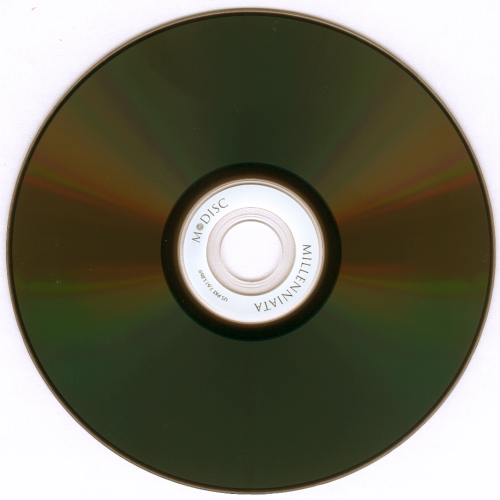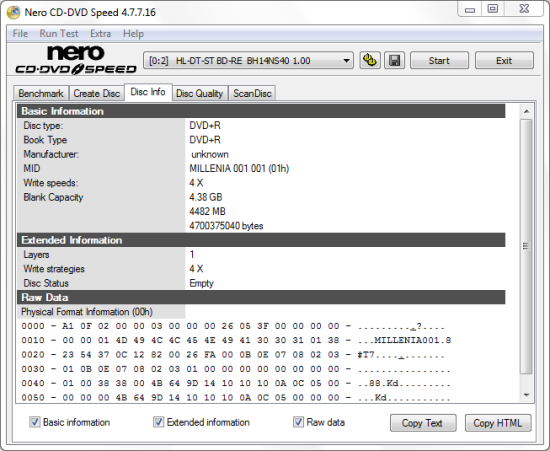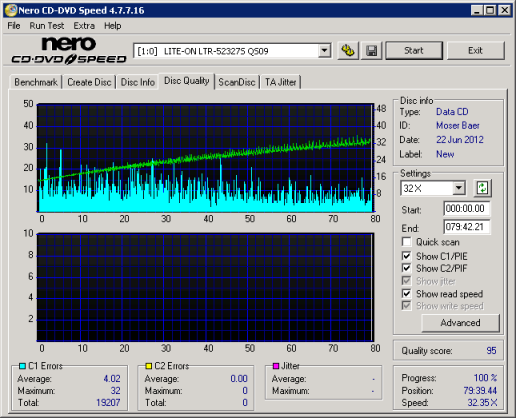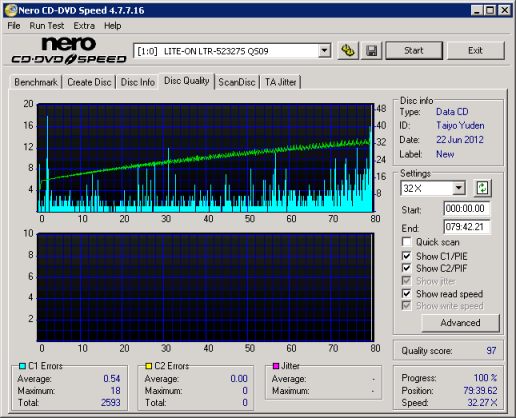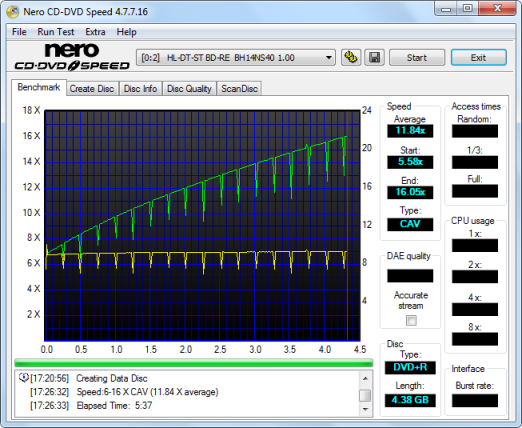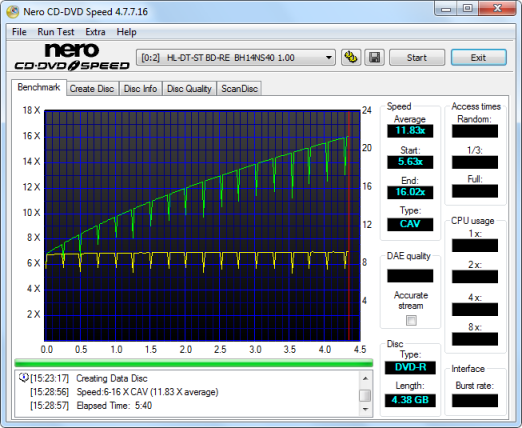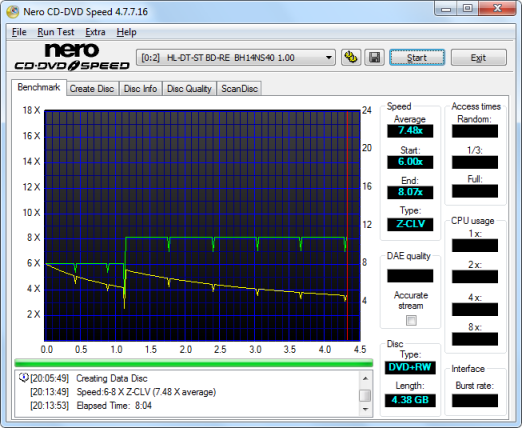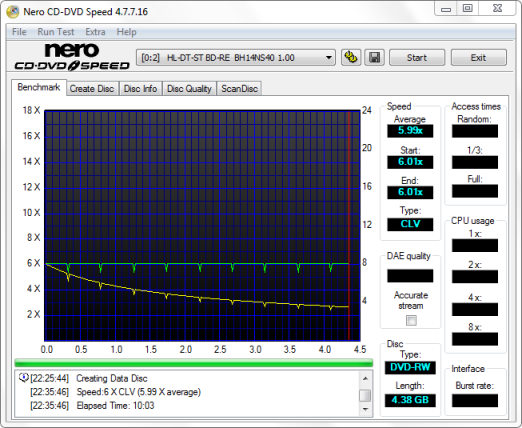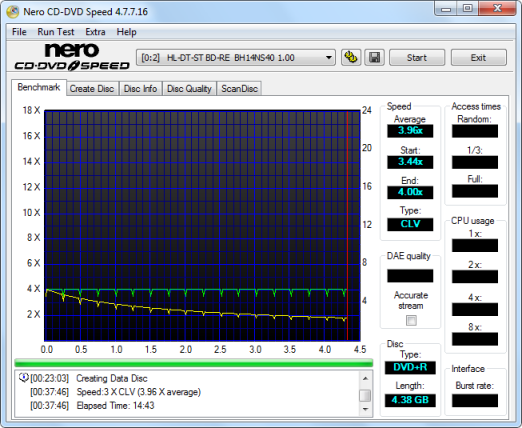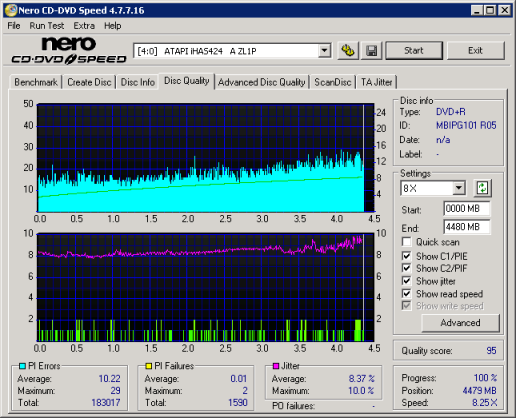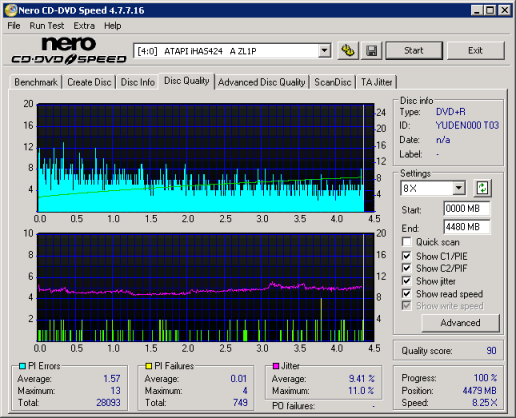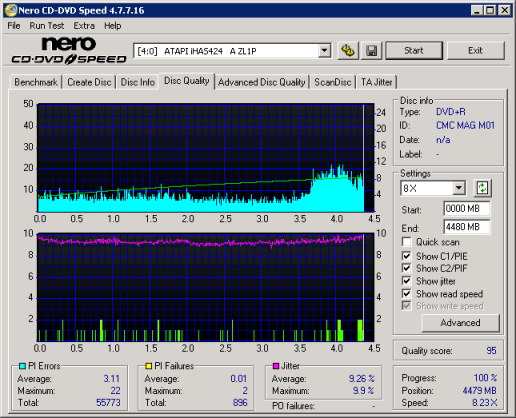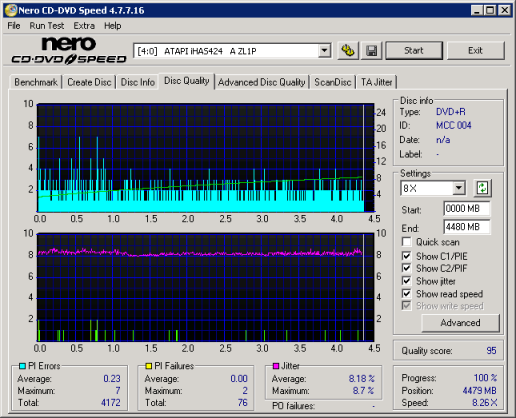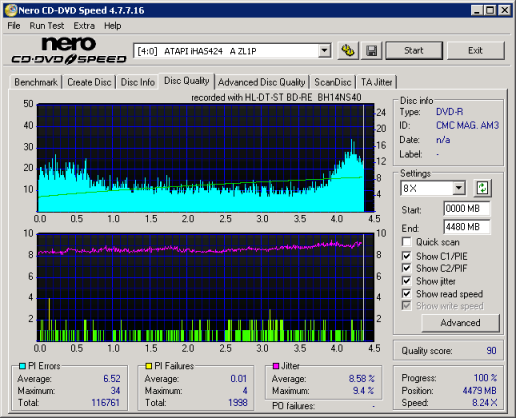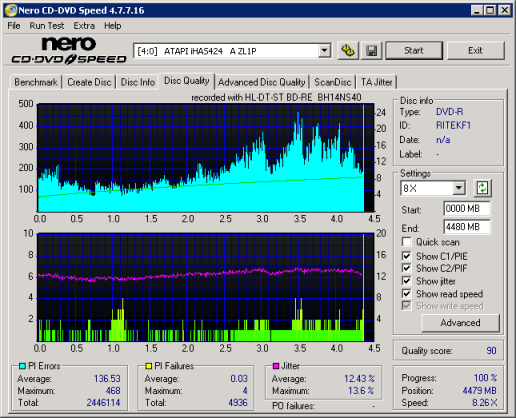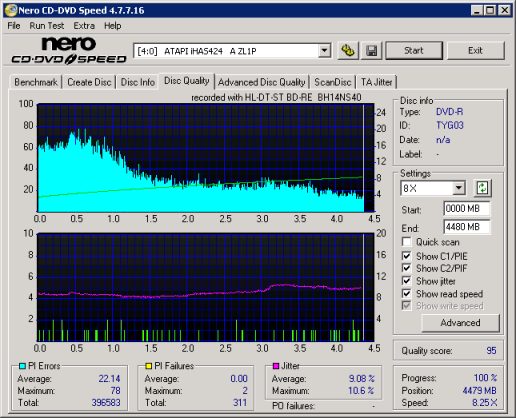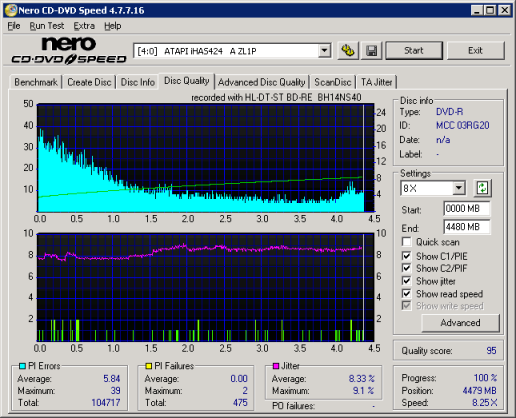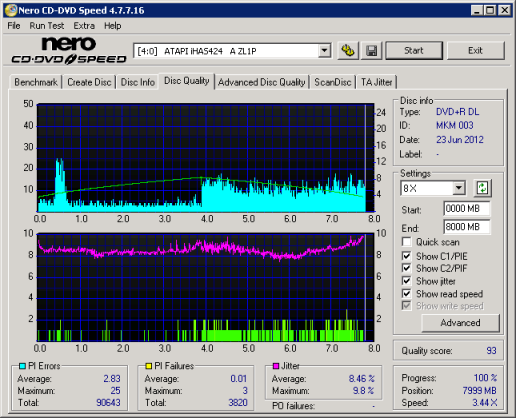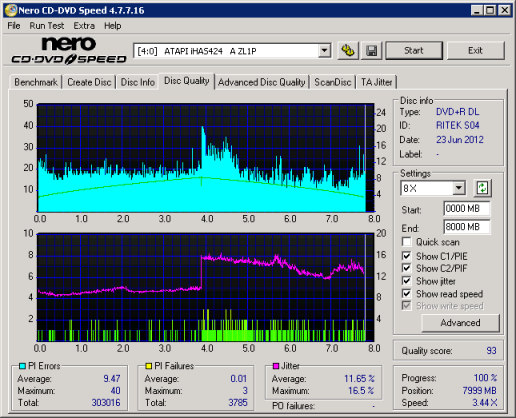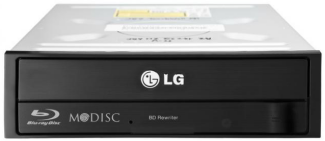

Model: LG BH14NS40 14x Blu-ray Disc ReWriter
Manufacturer: LG Electronics
Provided By: LG Electronics USA
LG Electronics has been a leader in the industry for more than 50 years. Since the introduction of their first radio in 1959, the company has grown to become one of the world's top electronics manufacturers, offering everything from large home appliances to tiny mobile phones. LG is no stranger to the optical storage industry either. Working closely with companies like Hitachi, they've lead the way in this area, developing and manufacturing a wide range of products, including the industry's first "Super-Multi" drives.

Like most drive manufacturers, LG has set their sites on the growing Blu-ray Disc market. The company currently offers a wide range of Blu-ray products, including a number of Super Multi Blue drives for the portable and desktop computer markets. This spring, LG introduced one of the industry's first 14x Blu-ray Disc rewriters, the BH14NS40. Featuring some of the fastest BD reading and writing speeds available, the BH14NS40 is capable of 14x BD-R, 12x BD-R DL, 6x BD-R LTH and 2x BD-RE writing speeds and a maximum BD-ROM read speed of 12x. The drive also offers support for 3 and 4-layer BDXL media as well as Millenniata's M-DISC technology which uses an inorganic rock-like material to provide up to 1000 years of permanent data storage.
With features and specs like this, it's hard not to be impressed by LG's new Blu-reay Disc rewriter. However, as you all know by now, we're not ones to take things at face value. In this review, we'll take an in-depth look at the BH14NS40's features and then see how it compares to some of the Blu-ray Disc writers from the competition. Does the BH14NS40 have what it takes? Is it the fastest Blu-ray Disc writer around? Keep reading as we find out.

What's in the box?:
- LG BH14NS40 14x Blu-ray Disc ReWriter
- Super Multi Blue Install Disc
- Owner's Manual
- Verbatim 6x BD-R Disc
- SATA Cable
- SATA Power Cable
- Mounting Screws
- Warranty Information
Physical Features:
The drive LG sent us for this review was manufactured in February of 2012 and had firmware version 1.00. At the time of this review, this is the only official firmware available for the BH14NS40.
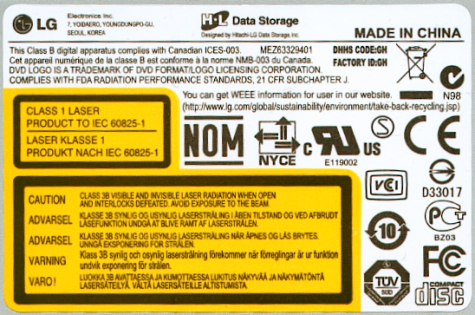
From the front, the BH14NS40 looks nothing like LG's previous Super Multi Blue drives. The glossy black plastic and silver highlights are gone and have been replaced by a flat bezel with faux brushed metal finish. The BH14NS40 still has its share of logos. Along with the large "LG" logo on the tray, you can see a few showing support for the Blu-ray Disc and M-DISC formats.

Like the eject button, the BH14NS40's single LED is flush with the bezel and is very hard to see when it is not lit. Off by default, the LED lights up a bright blue whenever the drive is reading or writing.

The rear of the BH14NS40 is pretty straightforward. By looking at the picture above you can see the drive's SATA interface and power connector.
Technical Specs:
The specs below have been taken from LG's website and the manual that came with the drive.
| LG BH14NS40 14x Blu-ray Disc ReWriter | |
| BD-R Write Speeds | 14x, 12x (CAV) 10x, 8x, 6x (P-CAV) 4x, 2x (CLV) |
| BD-R DL Write Speeds | 12x (CAV) 8x, 6x (P-CAV) 4x, 2x (CLV) |
| BD-R XL Write Speeds | 6x (Z-CLV) 4x, 2x (CLV) |
| BD-R LTH Write Speeds | 6x (P-CAV) 4x, 2x (CLV) |
| BD-RE Write Speeds | 2x (CLV) |
| DVD+R Write Speeds | 16x (CAV) 12x, 8x (P-CAV) 4x (CLV) |
| DVD+RW Write Speeds | 8x (Z-CLV) 6x, 4x, 2.4x (CLV) |
| DVD-R Write Speeds | 16x (CAV) 12x, 8x (P-CAV) 8x (Z-CLV) 4x, 2x (CLV) |
| DVD-RW Write Speeds | 6x, 4x, 2x, 1x (CLV) |
| DVD+R DL Write Speeds | 8x (P-CAV) 4x, 2.4x (CLV) |
| DVD-R DL Write Speeds | 8x (P-CAV) 4x, 2x (CLV) |
| DVD-RAM Write Speeds | 5x, 3x, 2x (CLV) |
| M-DISC Write Speeds | 4x (CLV) |
| CD-R Write Speeds | 48x (CAV) 40x, 32x, 24x (P-CAV) 16x, 8x (CLV) |
| CD-RW Write Speeds | 24x (Z-CLV) 16x, 10x, 4x (CLV) |
| BD Read Speeds | 12x Max (BD-ROM Single Layer) 8x Max (BD-ROM Dual Layer) 12x Max (BD-R) 8x Max (BD-R DL) 8x Max (BD-RE) 6x Max (BD-RE DL) 6x Max (BD-R LTH) 12x (BDMV) |
| DVD Read Speeds | 16x Max (DVD-ROM Single Layer) 12x Max (DVD-ROM Dual Layer) 16x Max (DVD±R) 12x Max (DVD±RW) 12x Max (DVD±R DL) 12x Max (DVD-Video) 5x Max (DVD-RAM) 12x Max (M-DISC) |
| CD Read Speeds | 48x Max (CD-ROM/CD-R) 40x Max (CD-RW) |
| DAE Speeds | 40x Max |
| Buffer Size | 4 MB |
| Access Times |
180 ms (BD-ROM) 160 ms (DVD-ROM) 180 ms (DVD-RAM) 150 ms (CD-ROM) |
| BD Formats | BD-ROM (SL/DL) BD-R (SL/DL/XL) BD-RE (SL/DL/XL) BD-R LTH BD-Video BD-MV |
| DVD Formats | DVD-ROM (SL/DL) DVD-R (SL/DL) DVD+R (SL/DL) DVD-RW DVD+RW DVD-RAM |
| CD Formats | CD-DA CD-ROM CD-ROM XA CD-I Video CD Photo CD CD-Extra CD-Text CD-R CD-RW |
More Features:
By looking at the picture below, you can see that LG's new Super Multi Blue drive is identified as an "HL-DT-ST BD-RE BH14NS40."

The Nero screenshot also shows that the BH14NS40 has a maximum CD writing speed of 48x and a 4096KB buffer. This buffer is also backed up by some form of buffer underrun protection. According to Nero, the BH14NS40 can write CD-Text and overburn. When testing the drive's capacity, it had no problems overburning up to 99 minutes with our CompUSA media.
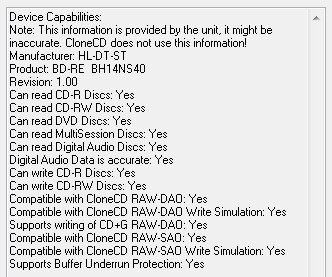
Using Alex Noe's Weak Sector Utility we were able to determine that the BH14NS40 is a "two sheep" burner. This means that LG's new drive is capable of backing up titles protected by SafeDisc 2, including version 2.51.
Here is a screen shot from Erik Deppe's Opti Drive Control. Among other things, this program queries the drive to see what its reading and writing capabilities are. Opti Drive Control had no problems detecting the BH14NS40's reading and writing speeds and supported disc types.

Opti Drive Control also shows that the BH14NS40 is an RPC-2 DVD drive. This means that the drive's region is stored in the firmware. The region can be changed five times and after that it cannot be changed anymore. Unfortunately, a patched RPC-1 firmware is not yet available for this drive.

While Opti Drive Control gives us a quick glance at the BH14NS40's features, DVDINFOpro provides a little more information on some of the drive's reading and writing capabilities. By looking at the screenshot above you can see that LG's new drive can read and write to most BD and DVD formats.
Oddly enough, the BH14NS40 does not support bitsetting. I tried a number of programs, including Nero and CD Speed, and none of them let me change the book type of DVD+R, DVD+RW or DVD+R DL media. After running a few tests, I found that the BH14NS40 does not automatically set the book type either. This really is too bad as setting the book type to "DVD-ROM" can greatly reduce compatibility problems, especially with older DVD players.
Current DVD technology uses organic dyes and low laser power to make marks on the data layer of a standard recordable DVD. Over time, these marks become unreadable because organic dyes degrade when exposed to minimal levels of light, heat, and humidity. This means all the data you thought was safely stored could be lost because the discs you used have an average lifespan of only about 3 to 5 years.
The materials and the write process used for the M-DISC were chosen with stability and longevity as the primary goals. Millenniata utilizes chemically stable and heat-resistant materials that are not used in any other DVD or optical disc. These materials cannot be overwritten, erased or corrupted by natural processes. The normal laser energy employed to write DVDs or CDs cannot successfully write to the inorganic and synthetic materials used in the M-DISC.
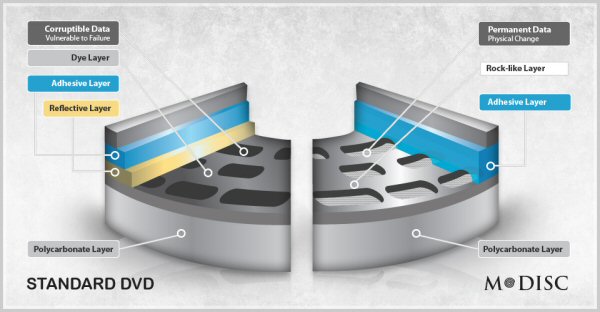
Data is stored on the M-DISC by physically altering the recording layer and creating permanent voids or holes. DVDs and other optical discs use organic dyes that break down over time, resulting in corrupt and unreadable data. These organic dyes are highly susceptible to temperature, humidity and even sunlight, starting to fade and decay the moment you record data.
Millenniata’s recording process utilizes higher temperatures than any ordinary optical disc. The inorganic data layer materials undergo a physical change during the write process. When the data layer is irradiated by a focused laser, the intense heat generated causes the innermost layers to melt and to move away from the laser spot, creating a hole or pit in the data layer.

These physical pits have two main advantages over dye and phase-change-based optical media; the permanent physical movement of the material, and the permanent optical contrast between light and dark spots. Movement of the material actually enhances the edge of the mark. The nanometer scale location of the edges is critical to the retention of data, with the enhanced edges further building-in longevity. The other advantage is the excellent, permanent optical contrast that comes from making a physical mark. The difference in optical quality between the pit, where there is no material, and the areas adjacent to the pit, where the material remains, provides a definite advantage in retention of data and in ease of reading the disc long into the future. Essentially, pits are better and allows for readable data even after hundreds of years.
While the same size and thickness as a standard DVD, Millenniata's M-DISC looks nothing like the other optical formats on the market today. For one, the top of the disc is brown and the bottom is silver. Also, with there being no reflective or dye layers, you can see right through the disc when placed in front of a bright light.
Here's a photo showing the Millenniata M-DISC next to other optical formats. From the upper left and moving clockwise you have a CD-R, BD-R, M-DISC and DVD-R.
Once written, the M-DISC can be read or played on any DVD drive that supports the DVD+R/RW format. Most DVD drives that were manufactured after 2005 and almost all Blu-ray or BD drives support this format.
For the BH14NS40's software bundle, LG has turned to CyberLink. The CD that comes with the drive contains the CyberLink Blu-ray Disc Suite which includes PowerProducer, Power2Go, PowerBackup, LabelPrint, MediaShow, MediaEspresso and PowerDVD.
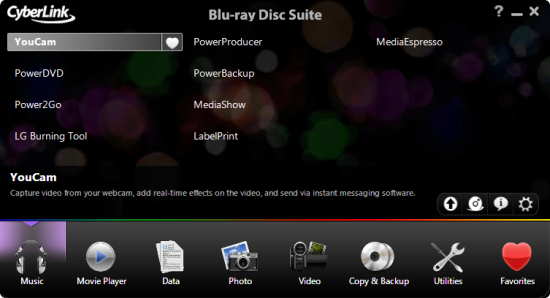
CyberLink PowerProducer 5 - With CyberLink's PowerProducer you can create your own movie discs quickly and easily. Right from the start, this wizard based software gives you a number of options to select from. From here you can choose to produce a new movie disc, edit an existing one or record video directly to DVD or BD.
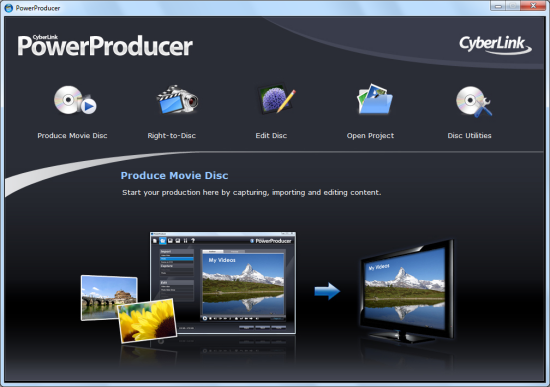
PowerProducer lets you create a number of different movie discs. Looking at the menu below, you can choose to create a CD, DVD, or Blu-ray Disc. The software also supports various disc capacities and formats including DVD-VR, DVD+VR and BDAV.
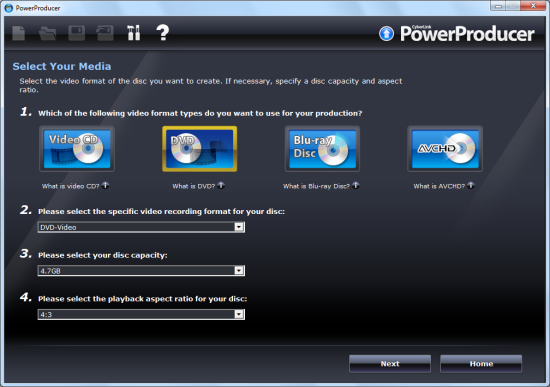
While you can capture your own video, PowerProducer gives you the ability to import video files in a number of different formats. Once added to your production, you can use the built-in editor to trim, merge or split your video clips. PowerProducer also allows you to set chapters within the video content and add your own custom menus, backgrounds, fonts and titles.
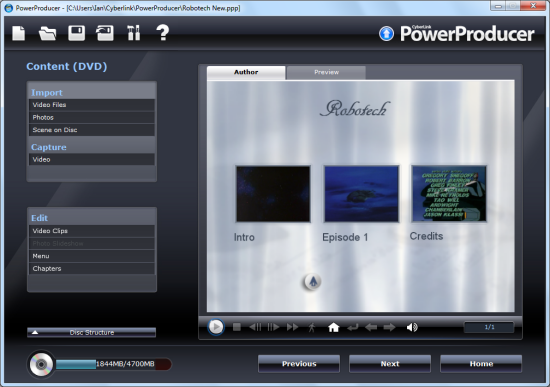
CyberLink Power2Go 6 - Power2Go is the main disc burning program included with the BH14NS40. With this software, users can create various types of CD's, DVD's and BD's or make backups of existing discs. Power2Go also offers enhanced security features, allowing you to password protect and encrypt the names of files on your discs.
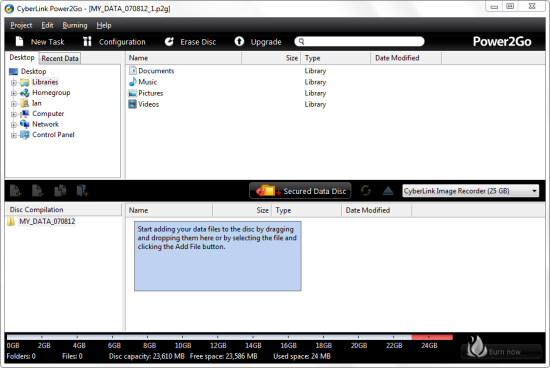
CyberLink PowerBackup 2.5 - If you're looking for a quick and easy way to backup your data, PowerBackup is the answer. Depending on your needs, PowerBackup can do full, differential, and incremental backups as well as fast stream-to-disc archiving.
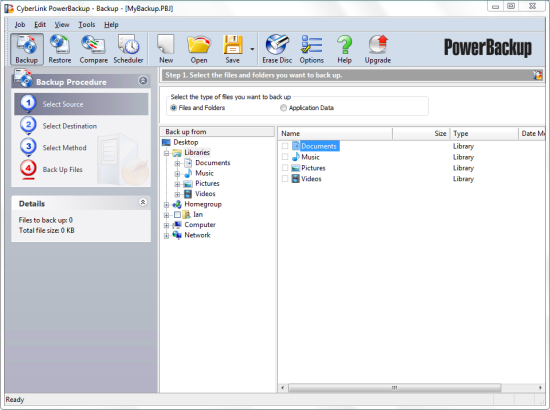
Backup jobs can be scheduled to run at regular intervals so the data is always protected. PowerBackup also offers more advanced features like file filtering, compression and password protection.
CyberLink LabelPrint 2.5 - The BH14NS40 also comes with CyberLink's disc labeling software. With LabelPrint, you can design and print labels, covers and inlays in four easy steps. Just select your template type, disc information, text layout, background image and print destination. LabelPrint also supports LightScribe technology, allowing you to burn images and text onto the top of your discs.
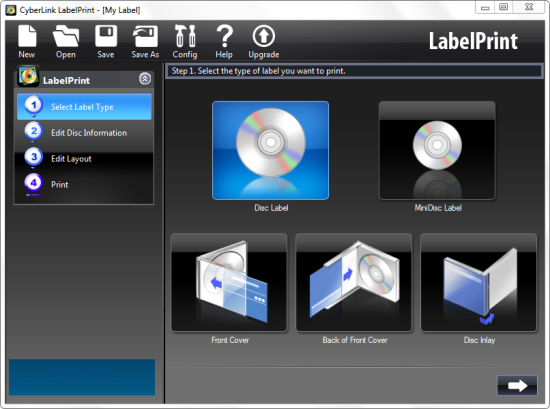
CyberLink MediaShow 4 - With MediaShow, you can manage, enhance and share your photos and videos. The software features drag-and-drop functionality as well as automatic sorting, built-in search, easy-to-add tags, and detailed thumbnails. MediaShow can also be used to fix and enhance your photos and videos and create a slideshow which can be burned to DVD, turned into a screensaver or uploaded to Flickr and YouTube.
CyberLink MediaEspresso 6.5 - MediaEspresso is a handy little tool that lets you quickly convert all of your media files into other formats so you can watch/view them on a mobile phone, portable media player, or game console. You can also convert files into many other popular formats, or into high quality files that you can then upload to YouTube or Facebook.
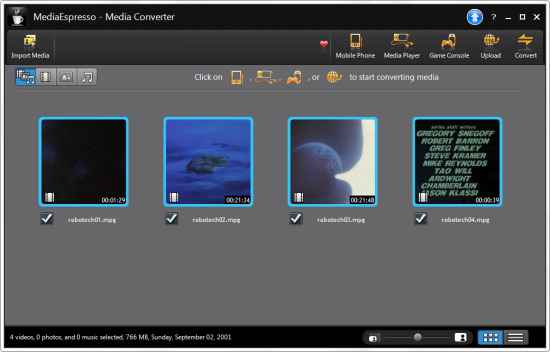
CyberLink PowerDVD 10 - CyberLink's PowerDVD is one of the more popular software DVD players on the market right now. Along with support for DVD's, it can be used to play back Blu-ray Discs and other high-def formats including H.264, HD MPEG-2, and WMV-HD. PowerDVD 10 also supports Blu-ray 3D playback and with its support for BD-Live, you can access additional content via the Internet.
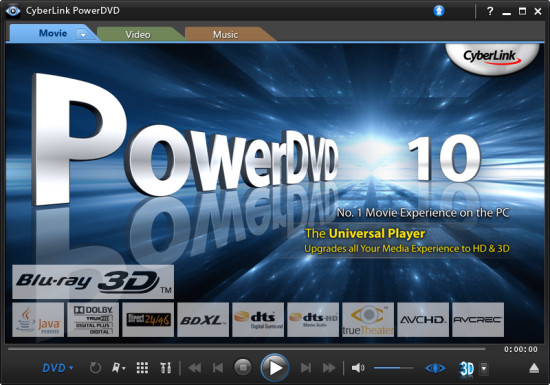
While affordably priced, LG's new Super Multi Blue drive delivers a good number of features. Along with support for all major CD and DVD formats, the BH14NS40 offers some of the fastest BD reading and writing speeds available. The drive is capable of 14x BD-R, 12x BD-R DL, 6x BD-R XL, 6x BD-R LTH and 2x BD-RE writing speeds and a maximum BD read speed of 12x. The BH14NS40 is also capable of writing to Millenniata's M-DISC media and includes features like a 4MB buffer and a great software bundle from CyberLink. With all this, it's easy to see why the LG BH14NS40 gets a solid 9 out of 10 for its features.
Along with smaller cable size, one of the biggest benefits of Serial ATA is its ease of installation. Because it uses a point to point connection, setting jumpers has become a thing of the past. In most cases, installation is as simple as plugging in the SATA and power cables and turning the computer on. Needless to say, it took only a couple of minutes to install LG's Super Multi Blue drive in our test computer. After making sure that the BH14NS40 was recognized by Windows, I was ready to start installing the software.
Software Installation:
As I mentioned earlier, the BH14NS40 comes with a CD full of software from CyberLink. If you have autorun enabled, the menu pictured below will automatically come up when you insert the disc.

As you can see, this menu is pretty straight forward. To start the setup process, simply click on the "Install Now" button. After selecting your preferred language and entering your customer information, you'll be presented with a list of components to choose from.

From here you can choose to install the BD Advisor, LabelPrint, MediaShow, MediaExpresso, LG Burning Tool (Power2Go), PowerBackup, PowerDVD, PowerProducer, YouCam or LG's firmware update utility. To complete the installation, select the components you want and click next a few more times. Once the files are copied over, you can start burning your own discs.
The Documentation:
Most of the BH14NS40's documentation is located in the "Owner's Manual." Similar to the ones included with LG's other drives, this manual covers a number of topics. It starts out by going over the BH14NS40's features, package contents and system requirements as well as the functions of the various buttons and connectors located on the front and back of the drive. While the diagrams are small, they are clearly labeled and easy to understand. You will also want to pay special attention to the system requirements, especially if you plan to play Blu-ray movies protected by AACS.
From here, the manual jumps into the physical installation of the drive. The instructions cover all the basics including how to install the BH14NS40 into an empty drive bay and hook up the cables. The manual continues on by going over the basic operation of the drive. It explains how to insert and eject a disc and how to get one out of the drive in case of an emergency. Last but not least, it finishes up with a short troubleshooting section and a page full of specifications for the BH14NS40.
Like LG's previous Super Multi Blue drives, the BH14NS40 was very easy to install. I had no problems getting the drive or the software installed and working. If you do run into trouble, the documentation LG has provided is more than sufficient. With this in mind, the BH14NS40 scores a 9 out of 10 for the installation portion of this review.
While CPU, memory, OS and other variables don't often make a huge difference, there are some nonetheless. We have a computer that is used only for testing hardware. We do this so all tests can be compared reliably.
Test System:
| CPU: | Intel Core i5-2500K 3.30 GHz | |
| Motherboard: | Gigabyte GA-H67MA-D2H-B3 (Intel H67 chipset) | |
| Memory: | G.Skill Sniper 8GB (2 x 4GB) DDR3 1333 (PC3 10666) | |
| Graphics: | Intel HD Graphics 3000 | |
| Hard Drive: | Seagate Barracuda 7200.12 SATA 3.0Gb/s 500GB | |
| Case | Cooler Master HAF 912 | |
| Operating System: | Windows 7 Enterprise x64 SP1 |
For Blu-ray Disc writers, the performance tests are normally broken down into six sections: CD read, CD write, DVD read, DVD write, BD read and BD write. Each benchmark test has been run three times. The score given is an average of the three.
CD Read Tests: For the read performance section of the CD-ROM benchmarks, CD Speed v4.7.7.16 is used to test read speeds, access times and CPU usage. For DAE testing, CD Speed is used to give an overall speed rating.
CD Write Tests: To test the write speeds, Nero Burning Rom is used to write 650MB and 700MB to our test media. Times are recorded. To test rewrite scores, Nero is used again to time how long it takes to write 400MB of random files and directories. Then CyberLink's InstantBurn is used to test packet writing speeds. The same files are copied and pasted in Windows Explorer and timed.
DVD Read Tests: For the read performance section of the DVD benchmarks CD Speed v4.7.7.16 is used to test read speeds, access times, and CPU usage.
DVD Write Tests: To test the DVD write speeds, Nero Burning Rom is used to write a 4.38GB image to our test media. Times are recorded. Then CyberLink's InstantBurn is used to test packet writing speeds. For this, 4GB of random files and directories are copied and pasted in Windows Explorer and timed.
BD Read Tests: For the read performance section of the BD benchmarks, CD Speed v4.7.7.16 is used to test read speeds, access times, and CPU usage.
BD Write Tests: To test the BD write speeds, CD Speed's "Create Data Disc" feature is used to burn an entire BD-R/RE disc. Times are recorded.
CD Speed v4.7.7.16 - Pressed CD:
For this test I used a pressed CD containing one Mode 1 data track. The disc is 74:38 in size and is full of data and directories.

| LG BH14NS40 |
LG BH12LS38 |
Plextor PX-LB950UE |
Sony BWU-500S |
|
| Transfer Speed Average: Start: End: |
35.89x 20.86x 47.44x |
35.04x 20.92x 47.68x |
35.86x 20.94x 47.42x |
35.89x 20.81x 47.49x |
| Access Times Random: 1/3: Full: |
123ms 128ms 197ms |
131ms 146ms 213ms |
116ms 135ms 202ms |
115ms 128ms 197ms |
| CPU Usage 1x: 2x: 4x: 8x: |
0% 1% 1% 3% |
0% 1% 2% 3% |
2% 1% 3% 6% |
2% 1% 3% 6% |
The BH14NS40 didn't perform as well as I had expected when reading pressed CD's. While rated at 48x, LG's new Blu-ray Disc writer came up a little short of this number in our tests. On a more positive note, the BH14NS40's access times were quite good.
CD Speed v4.7.7.16 - CD-R Media:
For this test I made a copy of our pressed test CD. I used 12x rated Memorex Gold 74 minute media for the tests.

| LG BH14NS40 |
LG BH12LS38 |
Plextor PX-LB950UE |
Sony BWU-500S |
|
| Transfer Speed Average: Start: End: |
36.67x 20.94x 48.59x |
36.08x 21.14x 47.62x |
36.64x 21.02x 48.57x |
36.67x 20.94x 48.63x |
| Access Times Random: 1/3: Full: |
130ms 128ms 203ms |
135ms 149ms 213ms |
121ms 132ms 200ms |
121ms 136ms 198ms |
| CPU Usage 1x: 2x: 4x: 8x: |
0% 1% 1% 3% |
0% 1% 2% 3% |
3% 2% 3% 6% |
2% 2% 3% 6% |
The BH14NS40 was a little faster when reading CD-R media. Thanks to this small speed boost, the drive was able to reach a maximum transfer speed of 48.59x in our tests.
While LG's new Blu-ray Disc writer had no problems recognizing our 99 minute CompUSA media, it slowed down considerably when reading it back. As you can see, the drive reached a maximum transfer speed of only 35.16x.

CD Speed v4.7.7.16 - CD-RW Media:
For this test I made a copy of a pressed test CD. I used some PNY 80 minute CD-RW media for the tests.

| LG BH14NS40 |
LG BH12LS38 |
Plextor PX-LB950UE |
Sony BWU-500S |
|
| Transfer Speed Average: Start: End: |
30.28x 17.56x 39.98x |
30.68x 17.86x 40.51x |
29.99x 17.39x 39.60x |
30.01x 17.46x 39.65x |
| Access Times Random: 1/3: Full: |
132ms 137ms 207ms |
130ms 145ms 205ms |
120ms 135ms 223ms |
121ms 137ms 214ms |
| CPU Usage 1x: 2x: 4x: 8x: |
0% 1% 1% 3% |
0% 1% 2% 3% |
1% 2% 3% 6% |
1% 2% 3% 6% |
While the BH14NS40 is rated at 48x when reading pressed and CD-R media, its CD-RW read speeds are limited to only 40x. As you can see, the drive came very close to reaching this speed in our tests.
CD Speed v4.7.7.7 (DAE) - Pressed CD:
For this test I used Pure Funk. The CD is almost exactly 74 minutes. This helps to squeeze the maximum performance out of the CD.

Exact Audio Copy can tell us a lot about a drive's capabilities. You can see from the screen shot that the LG BH14NS40 supports accurate stream, caches audio data and has the ability to retrieve C2 error information from audio CD's.

| CD Speed | LG BH14NS40 |
LG BH12LS38 |
Plextor PX-LB950UE |
Sony BWU-500S |
| Average: Start: End: DAE Quality: Accurate Stream: |
30.47x 17.86x 40.25x 10 Yes |
30.86x 18.28x 40.78x 10 Yes |
36.23x 24.92x 47.84x 10 Yes |
36.21x 21.69x 47.84x 10 Yes |
The BH14NS40 did fairly well in our DAE tests. While not as fast as the drives from Plextor and Sony, it was able to rip pressed audio CD's at at respectable 40.25x.
CD Speed v4.7.7.16 (DAE) - CD-R Media:
For this test I used a copy of the Pure Funk CD. It's burned onto the same Memorex Gold 74 minute media I used in the CD Speed tests.

| CD Speed | LG BH14NS40 |
LG BH12LS38 |
Plextor PX-LB950UE |
Sony BWU-500S |
| Average: Start: End: DAE Quality: Accurate Stream: |
30.18x 17.75x 39.79x 10 Yes |
30.26x 18.07x 39.90x 10 Yes |
35.90x 24.89x 47.30x 10 Yes |
35.87x 21.59x 47.31x 10 Yes |
The BH14NS40 was a little slower when extracting audio from CD-R media. While the drive still performed relatively well, it reached a maximum DAE speed of only 39.79x. So how did it do in CD Speed's advanced DAE tests? Take a look below.

LG's new Blu-ray Disc writer completed CD Speed's advanced DAE tests with an average score of 28.69x. The drive did not create any errors, but for whatever reason, it was not able to pass all of the on-the-fly copying tests. If you look at the advanced features, you can see that the BH14NS40 was able to read the CD-Text, subchannel data and lead in but failed to read the lead out section of the CD.
CD Write and ReWrite Tests - Nero Burning Rom 9.4.26.0 and InstantBurn 5:
For this test I randomly generated 650MB and 700MB of files and directories to test the time it takes the drive to write and close a CD. All of the files are between 1MB and 25MB in size and no more than 10 directories deep.
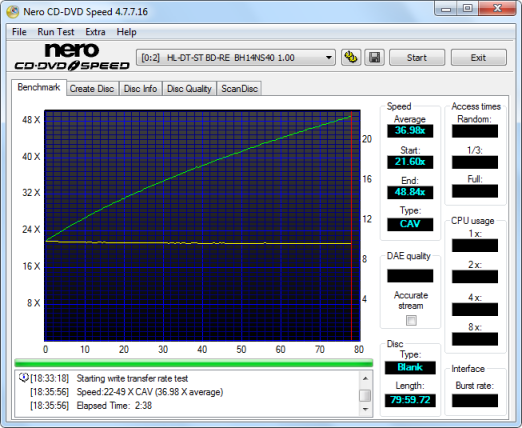
The BH14NS40 has a maximum CD writing speed of 48x. To reach this speed, it uses CAV, or Constant Angular Velocity. With Taiyo Yuden's 52x media, the drive starts writing at about 21.60x and accelerates, reaching a maximum speed of 48.84x at the end of the session. This gave LG's new drive an average writing speed of about 36.98x.
To test the drive's writing times, I wrote our test data to some Taiyo Yuden media rated at 52x. The results are below.
| Size in MB | Size in Time | LG BH14NS40 |
LG BH12LS38 |
Plextor PX-LB950UE |
Sony BWU-500S |
| 701MB | 79:44:21 | 2:41 | 2:40 | 2:47 | 2:48 |
LG's new drive did very well in our CD writing tests. Thanks to its 48x CD writing speed, the BH14NS40 was able to write an entire 701MB CD in 2:41.
To test the drive's writing quality I used Nero CD Speed. This utility can be used to test the number of C1 and C2 errors as well as the jitter level on a disc. For these tests I used a Lite-On LTR-52327S and read the discs at 32x.
The BH14NS40's writing quality was very good. By looking at the screenshots, you can see that the discs burned by the drive had a low number of C1 errors. More importantly, there were no C2 errors at all.
For the rewriting tests I created 400MB of files on the hard drive and wrote them in DAO mode using Nero. To test the packet writing speeds I copied and pasted the same files off the hard drive onto a CD-RW disc using InstantBurn from CyberLink. Verbatim's 24x Ultra Speed CD-RW media was used for these tests.
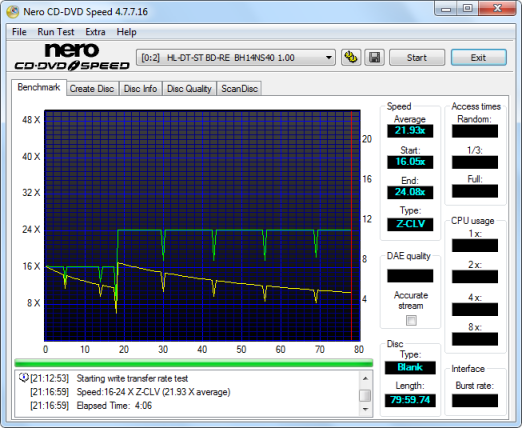
While the BH14NS40 uses CAV when writing to CD-R discs, it uses Z-CLV, or Zone CLV, when rewriting at 24x. The drive starts rewriting at about 16x and then jumps to its maximum speed at the 18 minute mark.
| Software | LG BH14NS40 |
LG BH12LS38 |
Plextor PX-LB950UE |
Sony BWU-500S |
| Nero | 2:45 | 2:28 | 2:49 | 2:48 |
| InstantBurn Write | 2:36 | 2:27 | 2:42 | 2:40 |
| InstantBurn Read | 1:57 | 3:05 | 1:55 | 1:55 |
LG's new Blu-ray Disc writer didn't do as well as some of the other drives we've tested. Due to its Z-CLV writing method, the BH14NS40 took 2:45 to write 400MB with Nero and 2:36 to do the same with InstantBurn.
Nero CD Speed v4.7.7.16 - DVD-R and DVD-RW:
First, we'll look at the drive's DVD-R and DVD-RW reading performance. For this I made copies of our DVD-ROM test disk using some general use 16x DVD-R and 6x DVD-RW media from Verbatim and then ran our usual DVD read tests with CD Speed. For the DVD-RAM tests, media from Maxell was used. The results are below.
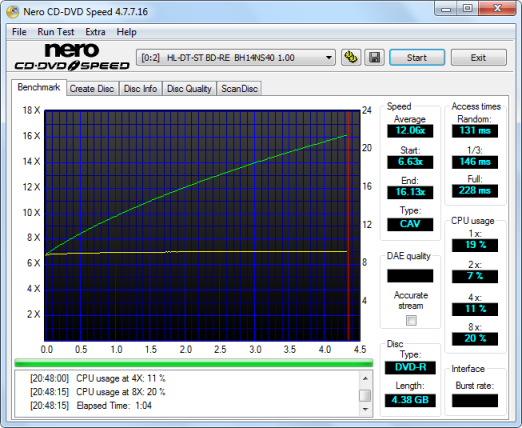
Verbatim DVD-R
| LG BH14NS40 |
LG BH12LS38 |
Plextor PX-LB950UE |
Sony BWU-500S |
|
| Transfer Speed Average: Start: End: |
12.06x 6.63x 16.13x |
12.33x 6.84x 16.48x |
12.06x 6.69x 16.11x |
12.05x 6.72x 16.11x |
| Access Times Random: 1/3: Full: |
131ms 144ms 227ms |
117ms 129ms 193ms |
121ms 133ms 235ms |
119ms 132ms 221ms |
| CPU Usage 1x: 2x: 4x: 8x: |
19% 7% 11% 20% |
4% 7% 12% 60% |
6% 11% 18% 31% |
6% 11% 17% 29% |

Verbatim DVD-RW
| LG BH12LS38 |
Plextor PX-LB950UE |
Sony BWU-500S |
LG BH14NS40 |
|
| Transfer Speed Average: Start: End: |
9.12x 5.01x 12.20x |
9.17x 5.07x 12.26x |
9.17x 5.10x 12.26x |
9.17x 5.08x 12.26x |
| Access Times Random: 1/3: Full: |
132ms 156ms 227ms |
119ms 135ms 231ms |
125ms 146ms 228ms |
118ms 148ms 225ms |
| CPU Usage 1x: 2x: 4x: 8x: |
7% 7% 11% 19% |
6% 11% 18% 31% |
6% 11% 18% 31% |
5% 11% 16% 30% |

Verbatim DVD-R DL
| LG BH14NS40 |
LG BH12LS38 |
Plextor PX-LB950UE |
Sony BWU-500S |
|
| Transfer Speed Average: Start: End: |
9.14x 5.07x 12.18x |
9.29x 5.18x 12.39x |
9.07x 5.06x 12.09x |
9.07x 5.05x 12.08x |
| Access Times Random: 1/3: Full: |
142ms 178ms 239ms |
130ms 144ms 226ms |
124ms 142ms 241ms |
124ms 136ms 244ms |
| CPU Usage 1x: 2x: 4x: |
12% 5% 9% |
3% 13% 61% |
5% 9% 15% |
5% 10% 15% |
The BH14NS40 had no problems reading DVD-R, DVD-RW and DVD-R DL media. In our tests, the drive read DVD-R discs at 16x, and both DVD-RW and DVD-R DL media at a respectable 12x.

Maxell 5x DVD-RAM
| LG BH14NS40 |
LG BH12LS38 |
Plextor PX-LB950UE |
Sony BWU-500S |
|
| Transfer Speed Average: Start: End: |
4.99x 4.94x 5.00x |
10.04x 6.13x 12.32x |
10.27x 4.67x 12.40x |
10.27x 6.01x 12.05x |
| Access Times Random: 1/3: Full: |
141ms 172ms 239ms |
159ms 163ms 215ms |
151ms 156ms 23ms |
136ms 158ms 213ms |
| CPU Usage 1x: 2x: 4x: 8x: |
3% 6% 9% n/a |
5% 8% 13% n/a |
6% 9% 15% 26% |
4% 9% 15% 28% |
While the other Blu-ray drives can read DVD-RAM discs at 12x, the BH14NS40 has a maximum read speed of only 5x. By looking at the screenshot you can see that it reads at this speed from start to finish.
Nero CD Speed v4.7.7.16 - DVD+R and DVD+RW:
Next we'll look at the drive's DVD+R and DVD+RW reading performance. For this I made a copy of our DVD-ROM test disk using some 16x DVD+R and 8x DVD+RW media from Verbatim. I then ran our usual DVD read tests with CD Speed. The results are below.
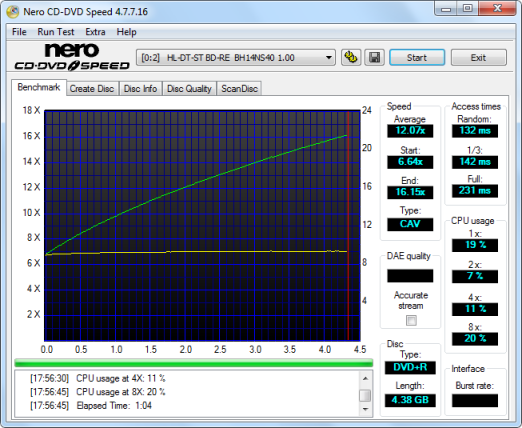
Verbatim DVD+R
| LG BH14NS40 |
LG BH12LS38 |
Plextor PX-LB950UE |
Sony BWU-500S |
|
| Transfer Speed Average: Start: End: |
12.07x 6.64x 16.15x |
12.34x 6.83x 16.49x |
12.06x 6.69x 16.12x |
12.06x 6.72x 16.12x |
| Access Times Random: 1/3: Full: |
132ms 141ms 231ms |
117ms 125ms 193ms |
119ms 129ms 215ms |
120ms 130ms 222ms |
| CPU Usage 1x: 2x: 4x: 8x: |
19% 7% 11% 20% |
4% 6% 12% 61% |
8% 11% 17% 32% |
8% 11% 17% 30% |

Verbatim DVD+RW
| LG BH14NS40 |
LG BH12LS38 |
Plextor PX-LB950UE |
Sony BWU-500S |
|
| Transfer Speed Average: Start: End: |
9.14x 5.04x 12.21x |
9.30x 5.17x 12.43x |
9.17x 5.11x 12.24x |
9.19x 5.12x 12.28x |
| Access Times Random: 1/3: Full: |
135ms 159ms 230ms |
111ms 130ms 208ms |
118ms 126ms 233ms |
117ms 128ms 233ms |
| CPU Usage 1x: 2x: 4x: 8x: |
7% 7% 11% 19% |
4% 7% 12% 59% |
6% 11% 18% 30% |
6% 11% 17% 30% |
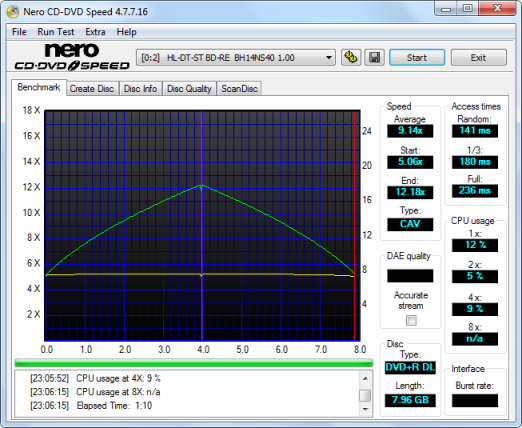
Verbatim DVD+R DL
| LG BH14NS40 |
LG BH12LS38 |
Plextor PX-LB950UE |
Sony BWU-500S |
|
| Transfer Speed Average: Start: End: |
9.14x 5.06x 12.18x |
9.29x 5.18x 12.39x |
9.07x 5.05x 12.09x |
9.07x 5.06x 12.09x |
| Access Times Random: 1/3: Full: |
141ms 180ms 236ms |
130ms 144ms 226ms |
123ms 125ms 227ms |
121ms 128ms 220ms |
| CPU Usage 1x: 2x: 4x: |
12% 5% 9% |
3% 13% 61% |
5% 9% 15% |
5% 9% 15% |
The BH14NS40's performance was very similar to what we saw with DVD-R, DVD-RW and DVD-R DL media. The drive read DVD+R discs at 16x and both DVD+RW and DVD+R DL media at 12x.
Nero CD Speed v4.7.7.16 - DVD-Video:
For these tests I am using the US version of Transformers: The Movie on DVD. The disc is over 4GB and single sided.

| LG BH14NS40 |
LG BH12LS38 |
Plextor PX-LB950UE |
Sony BWU-500S |
|
| Transfer Speed Average: Start: End: |
9.06x 4.98x 12.12x |
9.13x 5.06x 12.21x |
11.99x 6.65x 16.04x |
11.99x 6.66x 16.04x |
| Access Times Random: 1/3: Full: |
113ms 125ms 204ms |
125ms 140ms 212ms |
114ms 132ms 211ms |
119ms 132ms 222ms |
| CPU Usage 1x: 2x: 4x: 8x: |
6% 6% 11% 18% |
4% 6% 12% n/a |
5% 10% 17% 30% |
44% 41% 31% 37% |
The BH14NS40 didn't do as well as the drives from Plextor and Sony when reading DVD videos. In our tests, it reached a maximum speed of 12x when reading single layer discs.
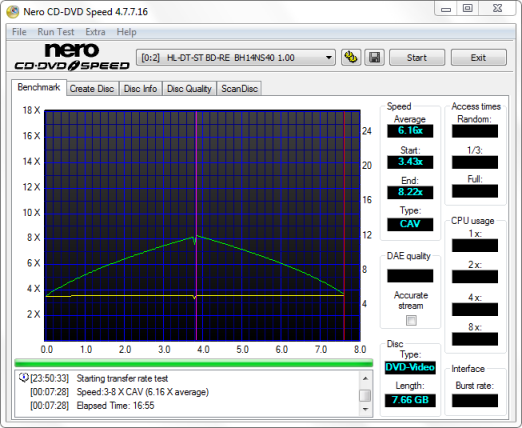
To see how well LG's new drive worked as a DVD player, I watched a few scenes from Transformers: The Movie and Star Wars: The Phantom Menace using the bundled version of PowerDVD. The BH14NS40 had no problems playing back either movie and was fairly quiet.
DVD Write and ReWrite Tests - Nero Burning Rom 9.4.26.0 and InstantBurn 5:
To test the DVD writing performance of LG's new drive I used Verbatim 16x DVD+R, 16x DVD-R, 6x DVD-RW and 8x DVD+RW media. To get the writing times, a 4.38GB image was burned to our test discs using Nero.
When writing to DVD+R and DVD-R media at 16x, the BH14NS40 uses CAV. By looking at the screenshots above, you can see that LG's new drive starts writing at about 5.6x and accelerates, reaching its maximum speed at the end of the disc.
The BH14NS40 also features 8x DVD+RW and 6x DVD-RW writing speeds. While the drive uses CLV when writing to DVD-RW media, it uses Z-CLV to reach its maximum DVD+RW writing speed.
When writing to M-DISCs, the BH14NS40 uses CLV. The drive starts writing at 4x and stays at this speed throughout the entire session.
| LG BH14NS40 |
LG BH12LS38 |
Plextor PX-LB950UE |
Sony BWU-500S |
|
| DVD+R | 5:40 | 5:48 | 5:37 | 5:41 |
| DVD-R | 5:41 | 6:00 | 5:45 | 5:47 |
| DVD+RW | 7:48 | 7:21 | 7:45 | 7:46 |
| DVD-RW | 10:03 | 9:54 | 10:47 | 10:44 |
| M-DISC | 14:46 | n/a | n/a | n/a |
The BH14NS40 performed fairly well in our DVD writing tests. While not nearly as fast as some of the 24x DVD writers we've looked at, it turned in some respectable times with both DVD±R and DVD±RW media.
To check the media compatibility of the BH14NS40, I ran a few tests using some of the media available in my area. The media types, along with the average time it took the drive to write our 4.38GB image, are listed below.
| Manufacturer ID | Max Write Speed |
Average Write Time |
|
| Moser Baer 16x DVD+R | MBIPG101 R05 | 16x | 5:40 |
| Taiyo Yuden 16x DVD+R | YUDEN000T03 | 16x | 5:40 |
| TDK 16x DVD+R | CMC MAG M01 | 16x | 5:37 |
| Verbatim 16x DVD+R | MCC-004 | 16x | 5:40 |
| HP 16x DVD-R | CMC MAG.AM3 | 16x | 5:40 |
| RiDATA 16x DVD-R | RITEKF1 | 16x | 5:39 |
| Taiyo Yuden 16x DVD-R | TYG03 | 16x | 5:41 |
| Verbatim 16x DVD-R | MCC 03RG20 | 16x | 5:41 |
So what about writing quality? Using CD Speed we can test a disc's PI (Parity Inner), PIF (Parity Inner Fail) and Jitter rates. For these tests I used a Lite-On iHAS424 and read the discs at 8x with the PI and PIF ECC sums set to 8 and 1 respectively.
So what are "good" results supposed to look like? When testing with the iHAS424, the PI errors should not exceed 280 and the number of PIF errors should stay below 4. Since POF errors are uncorrectable, we really don't want to see any of them at all.
I also put these discs through a "stress test" by reading them back at 16x. By reading these discs back at this speed, we can see if there are any readability issues caused by the number of errors or high levels of jitter.
The BH14NS40's writing quality was pretty good with most of the DVD+R media we tested. Aside from a few small spikes, the PI/PIF rates stayed within acceptable limits.
Lastly, here are some results from our DVD-R test media. While the writing quality varied from one manufacturer to another, the results were fairly good for the most part.
The writing quality was fairly good for the most part with Milleniata's M-DISC media. However, there was a sizable PIF spike at the 3.5GB mark which caused some readability problems. We saw similar results with the LG BP40NS20 which makes me think its an issue with this spindle of discs rather than the drive.
To test the BH14NS40's packet writing performance I used Drag-to-Disc 9.0. Verbatim 8x DVD+RW, Verbatim 6x DVD-RW and Maxell 12x DVD-RAM media were used once again.
| LG BH14NS40 |
LG BH12LS38 |
Plextor PX-LB950UE |
Sony BWU-500S |
|
| DVD+RW Write | 7:14 | 6:25 | 7:01 | 7:15 |
| DVD+RW Read | 12:55 | 8:08 | 7:20 | 6:19 |
| DVD-RW Write | 8:25 | 8:23 | 9:08 | 9:28 |
| DVD-RW Read | 6:40 | 8:54 | 6:23 | 6:20 |
| DVD-RAM Write | 21:59 | 16:19 | 11:31 | 11:11 |
| DVD-RAM Read | 11:16 | 6:09 | 5:34 | 5:33 |
The BH14NS40's packet writing performance was pretty mixed. While it turned in some respectable times with DVD+RW and DVD-RW media, it was not nearly as fast as the other drives when reading and writing to DVD-RAM discs.
Double Layer DVD Write Tests - Nero Burning Rom 9.4.26.0:
To test the double layer DVD writing performance of the BH14NS40, I used DVD+R DL media from Verbatim and RiDATA. I created about 8GB of random files and directories on my hard drive and then burned them to our test discs with Nero.
| LG BH14NS40 |
LG BH12LS38 |
Plextor PX-LB950UE |
Sony BWU-500S |
|
| DVD+R DL Write | 16:12 | 16:16 | 18:42 | 19:03 |
The BH14NS40 performed relatively well writing to DVD+R DL media. In our tests, the drive took 16:12 to write 8001MB of data to Verbatim's 8x DVD+R DL discs. So what about writing quality? Take a look below.
The BH14NS40's writing quality was pretty good with the DVD+R DL media from Verbatim and RiDATA. Aside from a few small spikes, the PI/PIF rates stayed within acceptable limits and there weren't any readability problems.
Nero CD Speed v4.7.7.16 - BD-ROM:
To test the BH14NS40's BD-ROM reading performance, I used the Blu-ray Disc version of The Fifth Element. This single layer disc is about 23GB in size.

| LG BH14NS40 |
LG BH12LS38 |
Plextor PX-LB950UE |
Sony BWU-500S |
|
| Transfer Speed Average: Start: End: |
8.98x 4.99x 11.99x |
3.62x 2.02x 4.83x |
6.05x 3.37x 8.08x |
6.05x 3.38x 8.08x |
| Access Times Random: 1/3: Full: |
92ms 157ms 218ms |
87ms 4ms 4ms |
75ms 190ms 245ms |
73ms 187ms 256ms |
| CPU Usage 1x: 2x: 4x: 8x: |
0% 0% 1% 1% |
0% 0% 1% 2% |
0% 1% 1% 2% |
0% 1% 1% 2% |
While the BH14NS40 is rated at 10x when reading single layer BD-ROM discs, its speeds are limited to only 4.8x when reading AACS protected titles. In our tests, the drive started reading at 2.02x and reached a maximum transfer speed of 4.83x.
LG's new Blu-ray Disc writer had no problems playing back The Fifth Element and The Simpsons Movie using the bundled version of PowerDVD. Just keep in mind that if your monitor is connected to your video card using DVI or HDMI, both need to be HDCP compliant to play AACS protected titles. If not, you can still play them by switching the connection to VGA or using software like Slysoft's AnyDVD HD.
Nero CD Speed v4.7.7.16 - BD-R and BD-RE:
Next we'll look at the drive's BD-R and BD-RE reading performance. For this I created a few data discs using single layer BD-R and BD-RE media from Memorex and TDK and then ran our BD read tests with CD Speed.

TDK BD-R
| LG BH14NS40 |
LG BH12LS38 |
Plextor PX-LB950UE |
Sony BWU-500S |
|
| Transfer Speed Average: Start: End: |
9.03x 5.12x 12.00x |
7.65x 4.35x 10.13x |
6.07x 4.47x 8.07x |
6.07x 3.47x 8.07x |
| Access Times Random: 1/3: Full: |
93ms 174ms 226ms |
120ms 5ms 4ms |
74ms 186ms 255ms |
73ms 182ms 259ms |
| CPU Usage 1x: 2x: 4x: 8x: |
0% 0% 1% 1% |
0% 1% 1% 3% |
0% 1% 1% 2% |
0% 1% 1% 2% |

Memorex BD-RE
| LG BH14NS40 |
LG BH12LS38 |
Plextor PX-LB950UE |
Sony BWU-500S |
|
| Transfer Speed Average: Start: End: |
6.12x 3.48x 8.13x |
6.10x 3.48x 8.10x |
6.07x 3.47x 8.07x |
6.07x 3.47x 8.07x |
| Access Times Random: 1/3: Full: |
84ms 170ms 228ms |
107ms 5ms 4ms |
75ms 182ms 258ms |
73ms 175ms 260ms |
| CPU Usage 1x: 2x: 4x: 8x: |
0% 0% 1% 1% |
0% 1% 1% 3% |
0% 1% 1% 2% |
0% 1% 1% 2% |

TDK BD-R DL
| LG BH14NS40 |
LG BH12LS38 |
Plextor PX-LB950UE |
Sony BWU-500S |
|
| Transfer Speed Average: Start: End: |
6.12x 3.50x 8.10x |
6.10x 3.49x 8.08x |
6.08x 3.49x 8.05x |
6.07x 3.48x 8.05x |
| Access Times Random: 1/3: Full: |
82ms 165ms 225ms |
105ms 5ms 4ms |
75ms 188ms 276ms |
73ms 184ms 262ms |
| CPU Usage 1x: 2x: 4x: 8x: |
0% 0% 1% 1% |
3% 1% 1% 3% |
0% 1% 1% 2% |
0% 1% 1% 2% |
LG's new drive had no problems reading BD-R, BD-RE and BD-R DL media. In our tests, the drive read BD-R discs at 10x, and both BD-RE and BD-R DL media at an impressive 8x.
BD Write and ReWrite Tests - Nero CD Speed v4.7.7.16:
To test the BD writing performance of LG's new drive I used BD-R, BD-R DL and BD-RE media from Moser Baer, Sony, TDK and Verbatim. To get the writing times, CD Speed's "Create Data Disc" feature was used. I also ran the discs through CD Speed's transfer rate test to make sure that the BH14NS40 could read them back.
The BH14NS40 is the first drive from LG that can write to BD-R media at 14x. By looking at the screenshot above, you can see that LG's new drive starts writing at 6.75x and accelerates, reaching its maximum speed at the 17.5 GB mark. From there it drops back down to 13x and then accelerates, reaching 14x again at the end of the disc.
| LG BH14NS40 |
LG BH12LS38 |
Plextor PX-LB950UE |
Sony BWU-500S |
|
| BD-R | 8:46 | 9:51 | 11:28 | 11:37 |
| BD-RE | 44:50 | 39:39 | 44:55 | 44:51 |
| BD-R DL | 21:55 | 21:43 | 31:29 | 33:00 |
The BH14NS40 performed very well when writing to BD-R media. It completed our tests in record time, beating even the BH12LS38 by more than a minute. LG's new drive didn't disappoint when writing to BD-R DL media either. Thanks to its 12x writing speed, the BH14NS40 took less than 22 minutes to burn 50GB worth of data.
| Manufacturer ID | Max Write Speed |
Write Time | ||
| Moser Baer 25GB 6x BD-R | MBI R06 | 10x | 11:23 | Transfer Rate |
| Sony 25GB 6x BD-R | SONY NN3 | 14x | 8:46 | Transfer Rate |
| Sony 50GB 6x BD-R DL | MEI RB1 | 12x | 21:55 | Transfer Rate |
| TDK 50GB 2x BD-RE DL | TDKBLDWfa | 2x | 89:32 | Transfer Rate |
| Verbatim 25GB 6x BD-R LTH | VERBATIMw | 6x | 16:06 | Transfer Rate |
| Verbatim 25GB 6x BD-R | VERBATIMe | 12x | 10:57 | Transfer Rate |
| Verbatim 25GB 2x BD-RE | VERBATIM0 | 2x | 44:50 | Transfer Rate |
The BH14NS40 completed our Blu-ray writing tests without any problems. The drive wrote to all of our test media at its rated speeds or better and, looking at the transfer rates, you can see that it had no problems reading the discs back.
Nevertheless, I should point out that if you want to write at 14x, you're going to need to use 6x BD-R media from Sony. Currently, this is the only BD-R disc that the BH14NS40 will write to at this speed.
Performance Revisited:
Like LG's previous Super Multi Blue drives, the BH14NS40 performed pretty well throughout most our tests. The drive flew through our BD writing tests, turning in some very impressive times with BD-R and BD-R DL media. Reading Blu-ray Discs wasn't a problem for the BH14NS40 either. The drive was able to read single layer BD-ROM's and BD-R discs at 12x and both BD-RE and BD-R DL media at 8x.
The BH14NS40 also did reasonably well in our CD and DVD read tests. Along with some fairly good seek times, the drive read CD's at speeds as high at 48x and single layer data DVD's and DVD±R media at 16x. When it came to writing CD's and DVD's, the BH14NS40 held its own throughout most of our tests and the writing quality was, for the most part, quite good. With all things considered, the LG BH14NS40 gets a solid 8 out of 10 for the performance section of this review.
Over the years, we've had a number of LG's Super Multi Blue drives in the 'Labs. With each new drive, they've raised the bar in regards to performance and features. The BH14NS40 continues this trend by offering some of the fastest BD reading and writing speeds available as well as support for Millenniata's M-DISC technology.
The BH14NS40 is the first drive from LG with the ability to write to BD-R media at 14x. At this speed, the drive completed our tests in record time, burning a full 25GB disc in less than 9 minutes. The BH14NS40 also performed very well when writing to BD-R DL media, burning a full 50GB BD-R DL disc in less than 22 minutes. The drive wasn't nearly as fast when writing to BD-RE media. However, its performance was on par with the other Blu-ray Disc writers I've tested. Without compatible media, I was not able to see how well the BH14NS40 supports the new BDXL format. These discs are still quite expensive and very hard to get a hold of in markets outside of Japan.
Using the bundled software, the BH14NS40 played all of the Blu-ray movies I had on hand, including those protected by BD+ and with BD-Live enabled features. The drive also performed fairly well in our transfer rate tests, reading single layer BD-ROM's and BD-R discs at 12x and both BD-RE and BD-R DL media at a respectable 8x.
LG's new drive also has the ability to read and write to all standard DVD formats. The BH14NS40 performed very well when writing to DVD±R discs, taking less than 6 minutes to burn an entire 4.7GB DVD. It also had no problems holding its own when writing to DVD±RW and DVD+R DL media. However, it lagged well behind the other drives when writing to DVD-RAM discs. Nevertheless, the BH14NS40 was fairly quick when reading DVD's. In our tests, it was able to read single layer DVD-ROM's and DVD±R discs at 16x and most other types of recordable media at 12x.
Reading and writing CD's wasn't a problem for the BH14NS40 either. In our tests, it read pressed and CD-R media at speeds as high as 48x and CD-RW discs at 40x. This level of performance carried over to our DAE tests, where the drive ripped audio CD's at speeds as high as 40x. As a writer, the BH14NS40 performed as expected. The drive turned in some respectable times with CD-R media and its writing quality was quite good. Unfortunately, due to its Z-CLV writing method, it wasn't as fast as some of the other drives in our rewriting tests.
LG's new Super Multi Blue drive also has its share of features. To prevent buffer underruns, the BH14NS40 is equipped with a generous 4MB buffer that is backed up by some sort of buffer underrun technology. The BH14NS40 also includes support for Millenniata's M-DISC technology. Offering greater longevity and durability than standard DVD's, the M-DISC's rock-like material provides up to 1000 years of permanent data storage. Last but not least, LG has included a great software bundle from CyberLink.
In the end, it usually comes down to price. For what it offers, LG's new Blu-ray Disc writer is surprisingly affordable. The retail packaged BH14NS40 can be purchased from Amazon or through retailers like Newegg for less than $130. If you don't need the extras the retail version includes, you can save some money by purchasing the OEM version for as little as $70.

| LG BH14NS40 14x Blu-ray Disc ReWriter |
|
| Features: Installation: Performance: |
9 9 8 |
| Overall: | 9 |
Highs:
- Writes to BD-R media at 14x
- Writes to BD-R DL media at 12x
- Writes to BD-R LtH media at 6x
- Writes to BD-R TL and BD-R QL media at 6x
- Writes to BD-RE, BD-RE DL and BD-RE TL media at 2x
- Writes to DVD-R and DVD+R media at 16x
- Writes to DVD+RW media at 8x
- Writes to DVD-RW media at 6x
- Writes to DVD+R DL and DVD-R DL media at 8x
- Reads single layer BD-ROM's and BD-R media at 12x
- Reads BD-RE and BD-R DL media at 8x
- Reads single layer DVD-ROM's and DVD±R media at 16x
- Reads DVD±RW and DVD±R DL media at 12x
- Features 48x CD-R and 24x CD-RW writing speeds
- Good DVD and CD writing quality
- Includes buffer underrun prevention technology
- Supports 99 minute CD-R media
- 4MB buffer
- Low access times
- Includes CyberLink's Blu-ray Disc Suite
- Nice looking design with bright blue LED
- Affordably priced
Lows:
- High media requirements when writing to BD-R media at 14x
- Reads and writes to DVD-RAM media at only 5x
- Does not support bitsetting


